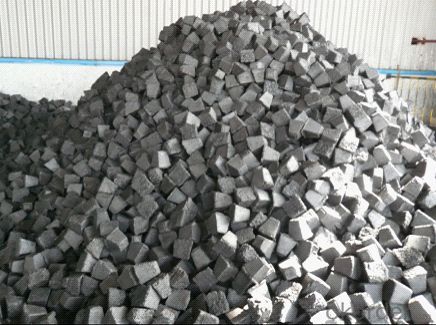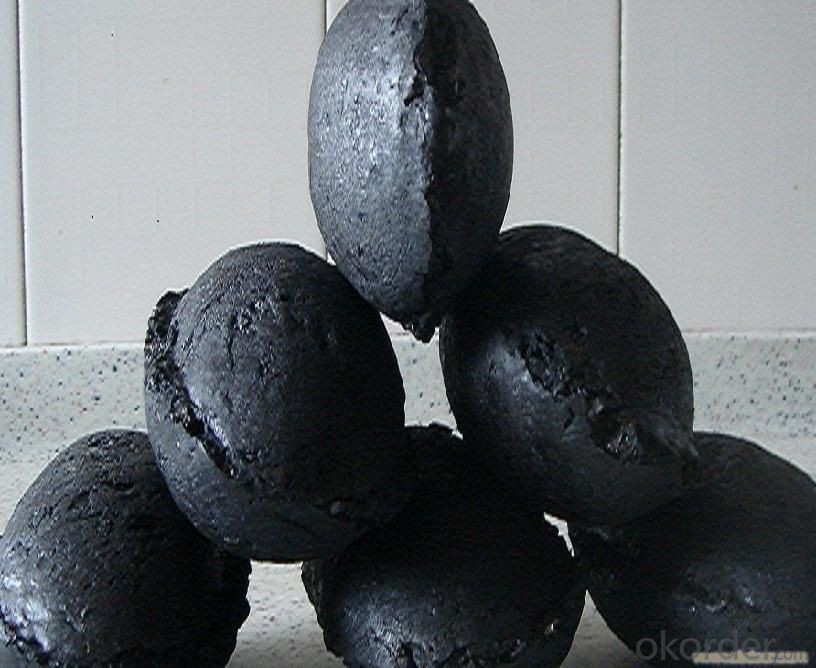Low Ash Carbon Electrode Paste -With Ash4-9
- Loading Port:
- Lianyungang
- Payment Terms:
- TT OR LC
- Min Order Qty:
- 20 m.t.
- Supply Capability:
- 600 m.t./month
OKorder Service Pledge
OKorder Financial Service
You Might Also Like
Low Ash Carbon Electrode Paste -With Ash4-9
Product Describtion
Carbon Electrode Paste is a self-baking electrode used in submerged arc furnaces for delivering power to the charge mix. Electrode Paste is added to the top of the electrode column in either cylindrical or briquette form. As the paste moves down the electrode column the temperature increase causes the paste to melt and subsequently bake forming a block of electrically conductive carbon. Electrode Paste is essentially a mix of Electrically Calcined Anthracite (ECA) or Calcined Petroleum Coke (CPC) with Coal Tar Pitch.
Main Function And Features
1) Low ash content
2) Good electric and thermal conductivity
3) High resistance to temperature
4) Stable quality
5) Reasonable price
6) Size:all kinds of electrode paste
7) Accord customer's reques change
Carbon Electrode Paste Specification
parameter unit gurantee value
Ash.( % ) 4.0 max5.0 max 6.0 max 7.0 max 9.0 max 11.0 max
V.M (%) 12.0-15.512.0-15.512.0-15.59.5-13.511.5-15.511.5-15.5
Compress. 18.0 min17 min 15.7 min 19.6 min19.6 min19.6 min
Strength
Specific 65 max68 max 75 max 80 max 90 max 90 max
Resistance (μΩm)
Bulk Density 1.38 min1.38 min1.38 min1.38 min1.38 min1.38 min
Pictures


- Q:Are carbon fibers organic polymer materials?
- No, carbon fiber is not an organic polymer material, and carbon fiber is an inorganic polymer materialOrganic polymer compounds referred to as polymer compound or polymer, also known as polymer is composed of one or several structural units repeatedly (103~105) compound repeat connected. Their elements are not many, mainly carbon, hydrogen, oxygen and nitrogen, but the molecular weight is large, generally above 10000, high millions.
- Q:What is the relationship between carbon and climate change?
- The relationship between carbon and climate change is that carbon dioxide (CO2), primarily emitted through human activities such as burning fossil fuels, is a greenhouse gas that contributes to the warming of the Earth's atmosphere. The excessive release of CO2 traps heat, leading to a rise in global temperatures and subsequent climate change impacts such as melting ice caps, rising sea levels, extreme weather events, and disruptions to ecosystems.
- Q:What is carbon nanocomposite coating?
- Carbon nanocomposite coating is a thin layer of material that contains carbon nanoparticles, which are dispersed within a polymer matrix. This coating is known for its exceptional strength, durability, and electrical conductivity, making it useful in various industries such as aerospace, automotive, and electronics.
- Q:What is methane?
- Methane is a colorless and odorless gas that is the primary component of natural gas. It is the simplest hydrocarbon, consisting of one carbon atom and four hydrogen atoms, and has the chemical formula CH4. Methane is highly flammable and burns in the presence of oxygen, releasing carbon dioxide and water vapor. It is produced naturally through the decomposition of organic matter by bacteria in environments with little or no oxygen, such as swamps, marshes, and landfills. Methane is also produced by livestock, such as cows, as a byproduct of their digestive process. It is considered a greenhouse gas and a major contributor to climate change due to its ability to trap heat in the Earth's atmosphere. Methane is widely used as a fuel for heating and cooking, as well as in industrial processes and electricity generation.
- Q:What are the effects of carbon emissions on the Arctic ecosystem?
- The Arctic ecosystem is significantly impacted by carbon emissions, primarily due to global warming. The release of carbon dioxide and other greenhouse gases into the atmosphere traps heat, leading to increased temperatures worldwide. However, the Arctic is particularly susceptible to these effects because of its unique characteristics. One of the most noteworthy consequences of carbon emissions on the Arctic ecosystem is the rapid melting of ice. Increasing temperatures cause glaciers and ice sheets to decrease in size, resulting in the loss of habitat for ice-dependent species like polar bears, walruses, and seals. These animals not only depend on the ice for resting and breeding but also for hunting and finding food. The reduction of their natural habitat has led to a decline in their populations, impacting the delicate balance of the Arctic food chain. Moreover, the melting of ice leads to rising sea levels, which can have cascading effects on coastal areas. Many Arctic communities, including indigenous peoples, are located near the coast and rely on the sea for their livelihoods. The increase in erosion, flooding, and storm surges due to rising sea levels pose a threat to their homes, infrastructure, and traditional ways of life. Furthermore, carbon emissions contribute to ocean acidification, a process in which excess carbon dioxide absorption by seawater lowers its pH level. This acidification has detrimental effects on marine organisms such as shellfish, corals, and plankton, which struggle to build and maintain their calcium carbonate structures. These organisms serve as essential food sources for various Arctic species, including fish, seabirds, and marine mammals. The decline in their populations disrupts the intricate web of life in the Arctic and can have far-reaching consequences. Climate change caused by carbon emissions also disrupts the timing and patterns of seasonal events, such as plant growth, bird migration, and the availability of food resources. This mismatch can have severe consequences for species that rely on specific timing for reproduction, migration, and survival. In summary, the effects of carbon emissions on the Arctic ecosystem are significant and extensive. The loss of sea ice, rising sea levels, ocean acidification, and disrupted ecological processes all contribute to the vulnerability of Arctic species and communities. Urgent action to reduce carbon emissions, mitigate climate change, and protect this fragile ecosystem is crucial for the long-term preservation of the Arctic.
- Q:How can carbon be stored underground?
- Carbon can be stored underground through a process called carbon capture and storage (CCS). This involves capturing carbon dioxide emissions from industrial processes or power plants, compressing it into a liquid form, and injecting it into deep underground geological formations, such as depleted oil and gas reservoirs or saline aquifers. The carbon dioxide is then trapped underground, preventing it from entering the atmosphere and contributing to climate change.
- Q:How do you make your own carbon fiber bar?Know. ID is how to make? Don't copy anything that has nothing to do with it
- 3. carbon fiber product form and manufacturing process carbon fiber has four kinds of products: fiber, fabric, prepreg, and chopped fiber. Cloth refers to fabric made from carbon fibers. Prepreg is a product in which carbon fibers are aligned in one direction and impregnated with carbon fibers or fabrics to form sheets. A staple fiber is a short fiber. These products, together with resins, will form carbon fiber reinforced plastics (CFRP) at different ratios. The resin is attached to the fiber and can be made into a pressure vessel and roll, which is wound around a core and then plasticized or hardened. This method is called "winding forming method"". Put the cloth into a model, and then soak it with resin. It can also be the body part of the production card. This is the "method of resin transfer molding (RTM)". The manufacture of aircraft elements is made by heating, pressing and plasticizing preforms in a autoclave. A strand of prepreg is wrapped around a core and heated and plasticized. This is known as the sheet winding method, which can be used to make a golf club, a fishing rod. The short silk is mixed with resin to form a mixture, which can be used to produce mountain machine components and other products after processing. In the past, prepreg was the most widely used form of carbon fiber, fabricated by sheet winding in a reactor. Recently, however, with the development of new industrial applications, filament winding, blending and other methods of prefabrication have been developed more widely. The use of molding such as RTM has enabled manufacturers to make larger products more efficiently. The combination of carbon fiber with the most suitable resin and prefabrication process makes the application of carbon fiber more attractive.
- Q:What is carbon fiber reinforced polymer?
- Carbon fiber reinforced polymer (CFRP) is a composite material that combines carbon fibers with a polymer matrix, resulting in a strong and lightweight material. Carbon fibers are thin, strong, and composed of carbon atoms bonded together in a crystalline structure. These fibers are embedded in a polymer matrix, typically made of epoxy resin, which binds the fibers together and provides support. The combination of carbon fibers and polymer matrix results in a material that has a high strength-to-weight ratio, making it ideal for various applications. CFRP is known for its exceptional stiffness, strength, and resistance to corrosion and fatigue. It is extensively used in aerospace, automotive, sports equipment, and other industries where lightweight and high-performance materials are required. The unique properties of CFRP make it an excellent alternative to traditional materials like steel, aluminum, and fiberglass, providing superior strength and durability while significantly reducing weight.
- Q:Something that seems to be used in the locomotive brake system. I haven't seen it, either. Who knows? It's better for the locomotive system to go back. Thank you!!
- The pantograph's bow head has several detachable electrically conductive strips of carbon or powder alloy used to contact the contact wire and power it from above.
- Q:Where do I buy DNF premium advanced carbon?
- And other activities, holidays, gift packs and so on, in the mall to buy, but now are colorless strengthening! Want to really want to use RMB to strengthen a little higher, directly to strengthen the volume!
1. Manufacturer Overview |
|
|---|---|
| Location | |
| Year Established | |
| Annual Output Value | |
| Main Markets | |
| Company Certifications | |
2. Manufacturer Certificates |
|
|---|---|
| a) Certification Name | |
| Range | |
| Reference | |
| Validity Period | |
3. Manufacturer Capability |
|
|---|---|
| a)Trade Capacity | |
| Nearest Port | |
| Export Percentage | |
| No.of Employees in Trade Department | |
| Language Spoken: | |
| b)Factory Information | |
| Factory Size: | |
| No. of Production Lines | |
| Contract Manufacturing | |
| Product Price Range | |
Send your message to us
Low Ash Carbon Electrode Paste -With Ash4-9
- Loading Port:
- Lianyungang
- Payment Terms:
- TT OR LC
- Min Order Qty:
- 20 m.t.
- Supply Capability:
- 600 m.t./month
OKorder Service Pledge
OKorder Financial Service
Similar products
New products
Hot products




























